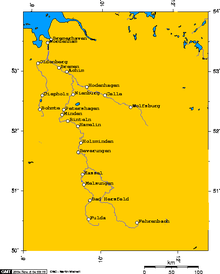Bremen: Difference between revisions
→External links: rm Space Center Bremen because it is now closed, this follows on from previous removal from Sights |
|||
| Line 76: | Line 76: | ||
* [http://www.iu-bremen.de/ International University Bremen] |
* [http://www.iu-bremen.de/ International University Bremen] |
||
* [http://www.panorama-cities.net/bremen/bremen.html City Panoramas Bremen] - Panoramic Views of Bremen's Highlights |
* [http://www.panorama-cities.net/bremen/bremen.html City Panoramas Bremen] - Panoramic Views of Bremen's Highlights |
||
* [http://www.freimarkt.de/en/index.htm Freimarkt website] |
* [http://www.freimarkt.de/en/index.htm Freimarkt website] |
||
* [http://www.space-center-bremen.de/sc/en/index.jsp Space Center Bremen] |
|||
=== History Links === |
=== History Links === |
||
Revision as of 14:48, 25 November 2004

Bremen [ˈbreːmən] is a city in northern Germany (official name: Freie und Hansestadt Bremen, referring to its membership in the medieval Hanseatic League) situated along the river Weser. Bremen is one of two towns belonging to the state of Bremen, the other being Bremerhaven. Population: 547,000.
History
In the 8th century the troops of Charlemagne advanced to the Weser in order to christianise the tribes settling here. Bremen, which may have been an older settlement, became a bishopric; a deed claiming the town's foundation in 788 has now been recognised as a forgery, so the exact date is unknown. In the following centuries the bishops of Bremen were the driving force behind the Christianisation of Scandinavia.
In the 12th century the power of the archbishops was challenged by Henry the Lion. The duke was successful and became the factual ruler of the town. These events led to a civil government and a loss of clerical power. Bremen became a merchants' town, and its ships dominated the southern portions of the North Sea. This dominance ended, when the Hanseatic League, originally a trade alliance of the Baltic Sea only, expanded to the North Sea. In the early 14th century ships from Bremen acted as pirates to board hanseatic cogs. In order to avoid open war aldermen from Bremen went to the Hanseatic Council in Lübeck and agreed to becoming members of the league (1358).
 |
 |
 |
Bremen remained a reluctant member of the Hanseatic League. The town demanded support for its wars against the chieftains of Frisia, who ruled the region around the Weser mouth, but they seldom joined campaigns in the Baltic Sea. In 1425 the conflict escalated, when the citizens burnt hanseatic documents on the market place. Bremen was expelled from the league in 1427. The consequences followed soon: the sudden loss of power led to territorial claims of neighbouring states (e.g. Oldenburg) and significant territorial losses.
On March 6, 1901 an assassin attempted to kill Wilhelm II of Germany here.
After World War II, Bremen became a part of the American occupation zone since the USA wanted to have one port town within their zone. This prevented the inclusion of Bremen into the new Land of Lower Saxony that was formed around it within the British zone, and secured Bremian independence as a Land of its own right in the new West German federation.
Historical population
- 1810: 35,800 inhabitants
- 1830: 43,700
- 1850: 55,100
- 1880: 111,900
- 1900: 161,200
- 1925: 295,000
Sights
- Town (1410); in front of the town hall there are the statues of Roland (1404) and of the Town Musicians (1953).
- Cathedral St. Petri (13th century), with sculptures of Moses and David, Peter and Paul, and Charlemagne.
- Liebfrauenkirche, oldest church of the town (11th century)
- Martinikirche (St. Martin), church on the Weser bank (1229)
- Schütting (1538), house of the merchants' guild
- Schnoor, a medieval quarter with narrow streets and nostalgic pubs
- Schlachte, the medieval harbour of Bremen (the modern port is some kilometres downstream)
Modern tourist attractions include
- Universum Science Center, a modern science museum
- botanika, an extension to a public park that attempts to the same as above Universum for biology
- Beck's Beer Factory, tours are available to the public which include beer tasting
Miscellaneous
Bremen has a large and famous university, and more recently the International University Bremen, and several high-tech industries have settled in the city. Many of Germany's space technology exports are manufactured in EADS SPACE Transportation facilities in Bremen, such as the Columbus module of the International Space Station, Europe's Arianespace rocket upper stages and many space probes and communication satellites. There is also a Mercedes-Benz factory in Bremen, building the SL and SLK series of cars.
Bremen has an international airport situated in the west of the city.
It is home of the soccer team SV Werder Bremen which won the German Football Championship for the fourth and the German Football Cup for the fifth time in 2004, making SV Werder Bremen just the fourth team in German football history to win the double. Beck's beer is brewed in Bremen.
Bremen is famous for a fairy tale by the Brothers Grimm, the Town Musicians of Bremen, although they never actually reach Bremen in the tale.
Every year since 1036 in the last two weeks of October Bremen hosts Freimarkt ("Free market"), Germany's oldest and one of today's biggest fairground festival.
Bremen is also host to one of the four big annual Techno parades, the Vision Parade.
See also: List of Mayors of Bremen.
External links
- Official city website
- Townmap
- University of Bremen
- Hochschule or University of applied sciences
- International University Bremen
- City Panoramas Bremen - Panoramic Views of Bremen's Highlights
- Freimarkt website
History Links
- http://www.genealogy.net/reg/BRE (Genealogical research in Bremen)
- http://www.schiffslisten.de (Database: Emigration via Bremen Ports 1920 - 1939)
- http://maus.genealogy.net (Die MAUS - Genealogical society of Bremen)
